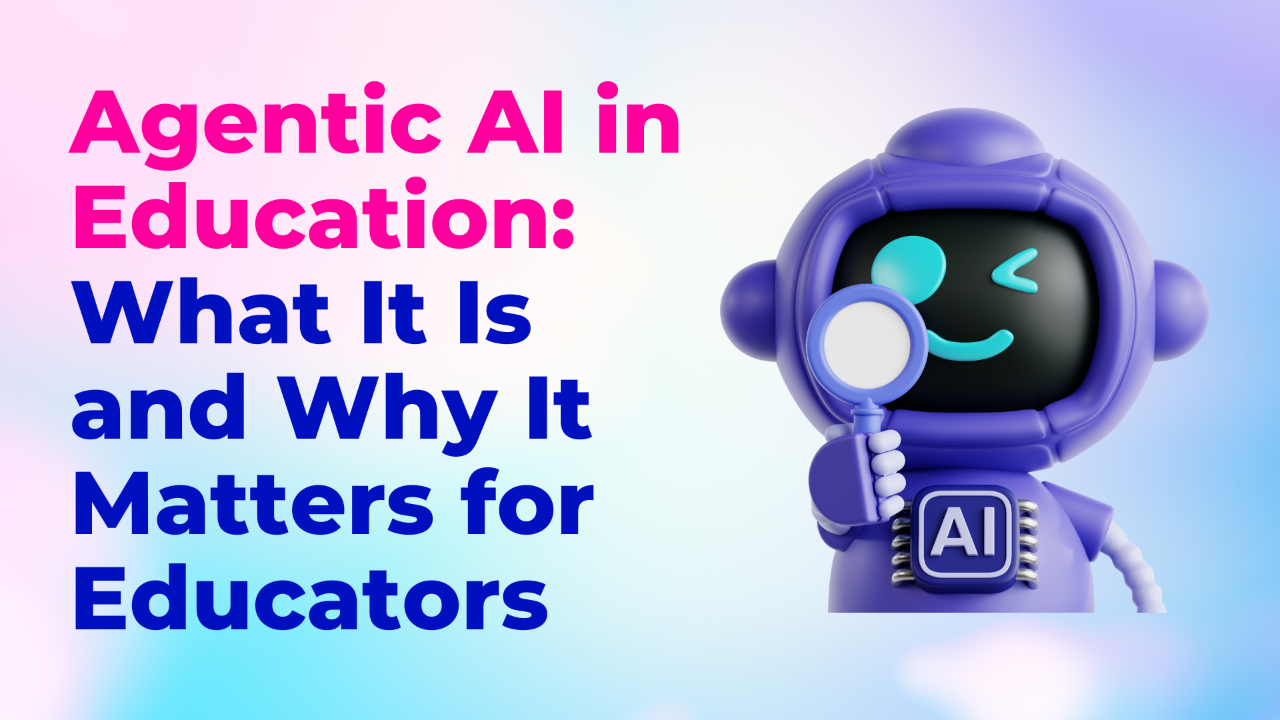
Agentic AI in Education: What It Is and Why It Matters for Educators
May 05, 2025Imagine this: You ask an AI to help plan a workshop. Instead of just offering tips, it books a room, emails participants, and sends reminders. It adapts if someone drops out, follows up with latecomers, and makes sure the event runs smoothly.
This isn’t science fiction. It’s a glimpse into the world of agentic AI—and it’s rapidly becoming a game-changer in education.
For educators in higher education and adult learning, agentic AI isn’t just the next big thing. It’s a practical shift in how we teach, assess, and support learning—freeing up time while enhancing impact.
What is Agentic AI, Really?
Let’s break it down.
Agentic AI refers to AI systems that can act independently toward a goal. Unlike traditional tools that wait for instructions, agentic AI can reason, make decisions, and carry out tasks—often with minimal input once it’s set up.
Think of it not as a chatbot waiting for questions, but as a co-pilot that sees where you’re headed and helps get you there.
From Chatbots to Co-Pilots: What It Means for Educators
In education, agentic AI unlocks new levels of autonomy and support—for both educators and learners. Here’s how it’s already making an impact:
-
Scheduling and communication: Agentic AI can auto-schedule tutorials, send reminders, and even notify you if student engagement starts to dip.
-
Personalised feedback: It can tailor suggestions, follow-ups, and resources to individual learning paths without needing constant oversight.
-
Course design support: Instead of building from scratch, AI can help plan an entire semester—flagging gaps in your syllabus, proposing activities, and aligning content with learning outcomes.
-
Essay grading at scale: Feed in your rubric once, and AI can assess essays with consistent, actionable feedback—saving hours without compromising quality.
-
Role-play assessment: Students can engage in scenario-based tasks, and AI scores them using teacher-defined rubrics, giving timely, formative insights.
-
Learning flow automation: Share your outcomes, and AI builds out lesson sequences, activities, and assessments that evolve with your learners’ progress.
-
Proactive nudging: Rather than waiting for students to ask for help, AI identifies when they need it—and steps in with smart prompts and support.
This isn’t automation for convenience. It’s about giving educators back time, while creating more responsive and inclusive learning environments.
Why Should Educators Care?
Agentic AI helps educators refocus their time and energy on what truly matters: teaching, mentoring, and innovating. Here’s how:
-
🧭 Strategic time savings: Offload time-consuming tasks like grading and scheduling.
-
🧑🎓 Support for diverse learners: Let AI personalise instruction and feedback at scale.
-
📈 Smarter data use: Get proactive alerts and insights—no need to dig through dashboards.
-
🌍 Global classroom readiness: Use multilingual support and scalable features to serve learners from different backgrounds.
-
💡 Future-focused teaching: Prepare students for a world where AI fluency is key.
What Does It Look Like in Practice?
Let’s meet Alex, a university lecturer:
-
Before agentic AI: Alex manually schedules all tutorial slots, chases late assignments, grades essays late into the night, and spends weekends preparing activities from scratch.
-
After agentic AI: Alex’s assistant builds learning flows based on course goals, evaluates essays using rubrics, reminds students automatically, and suggests personalised follow-ups—all while tracking engagement in real-time.
Alex isn’t doing less. Alex is doing more—with far less stress.
Wait—Isn’t This Just Automating Teaching?
Not quite. While agentic AI automates tasks, it doesn’t replace judgement. Educators remain in control—setting goals, defining quality, and guiding student growth. AI simply helps deliver those goals faster and more consistently.
With the right oversight, agentic systems can also reduce bias, improve accessibility, and create space for deeper, more human interactions in the classroom.
How to Get Started (No Tech Degree Needed)
You don’t need to be an AI expert to take advantage of this.
-
Pick one admin task to streamline—like reminders or essay grading.
-
Experiment with AI tools designed for education, especially ones that align with how you teach.
-
Join professional development sessions to see real-life examples.
-
Look for AI that acts, not just reacts—the kind that nudges, plans, and learns alongside you.
The Future Is Proactive—and It’s Already Here
AI is evolving—and it’s not just about faster answers or snappier feedback. It’s about having a digital partner that works with you, for your students.
Agentic AI isn’t just the next step in edtech—it’s a redefinition of what support looks like in modern teaching.
✅ Join our free AI in Education workshop series
Explore hands-on strategies, real-life use cases, and get complimentary access to a platform designed to support educators with AI that actually helps.
💡 Bonus: Curious about building your own AI tutor in 10 minutes a day?
Join our AI Tutor Challenge and start creating with guided steps and exciting rewards.

